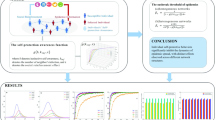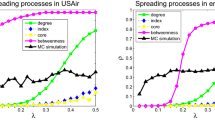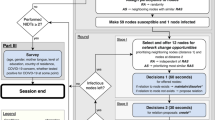Abstract
This work explores two key dimensions of the dissemination of information on disease prevalence during an outbreak. First, we point out the necessity of prevalence data to be collected (and communicated) in different scopes, ranging from direct contacts to the whole population. Second, we emphasize the need to minimize the time between the beginning of contagiousness and case reporting, striving for near real-time reporting. To demonstrate the significance of these two dimensions, we introduce an agent-based toy model with an SEIR scheme on a variety of network topologies (random, regular, small-world, and scale-free networks). We compare four different disease mitigation strategies: A base strategy, which allows uncontrolled spread, a global strategy, where susceptible agents reduce their infection probability according to the system-wide prevalence and two local strategies, where susceptible agents reduce their infection probability according to the prevalence among either their first-order or their first-and-second-order neighbors. Across all four network types, we find that the local strategies better reduce both the outbreak’s peak height and total size, with the first-order local strategy proving most effective. However, when a lag between becoming contagious and reporting one’s disease state is introduced, the prevalence information of one’s first order neighbors becomes less useful. In this scenario, the first-and-second-order local strategy performs as good as or better than the first-order local strategy in terms of reducing outbreak size, in all networks except the random network.
Access this chapter
Tax calculation will be finalised at checkout
Purchases are for personal use only
Similar content being viewed by others
References
Islam, M.S., et al.: COVID-19-related infodemic and its impact on public health: a global social media analysis. Am. J. Trop. Med. Hyg. 103(4), 1621–1629 (2020). https://doi.org/10.4269/ajtmh.20-0812
Zarocostas, J.: How to fight an infodemic. Lancet 395(10225), 676 (2020). https://doi.org/10.1016/S0140-6736(20)30461-X. ISSN: 0140-6736
Pian, W., Chi, J., Ma, F.: The causes, impacts and countermeasures of COVID-19 “Infodemic’’: a systematic review using narrative synthesis. Inf. Process. Manag. 58(6), 102713 (2021). https://doi.org/10.1016/j.ipm.2021.102713. ISSN: 0306-4573
Rosenstock, I.M.: Historical origins of the health belief model. Health Educ. Monogr. 2(4), 328–335 (1974). https://doi.org/10.1177/109019817400200403. ISSN: 0073-1455
Chen, F.H.: Modeling the effect of information quality on risk behavior change and the transmission of infectious diseases. Math. Biosci. 217(2), 125–133 (2009). https://doi.org/10.1016/j.mbs.2008.11.005. ISSN: 0025-5564
Sarkar, J.: Do disease prevalence and severity drive COVID-19 vaccine demand? Econ. Anal. Policy 75, 310–319 (2022). https://doi.org/10.1016/j.eap.2022.05.014. ISSN: 0313-5926
Litwin, H., Levinsky, M.: Network-exposure severity and self-protective behaviors: the case of COVID-19. Innov. Aging 5(2) (2021). https://doi.org/10.1093/geroni/igab015. ISSN: 2399-5300
Li, S., Feng, B., Liao, W., Pan, W.: Internet use, risk awareness, and demographic characteristics associated with engagement in preventive behaviors and testing: cross-sectional survey on COVID-19 in the United States. J. Med. Internet Res. 22(6), e19782 (2020). https://doi.org/10.2196/19782. ISSN: 1438-8871
Corona-Warn-App Open Source Project. Open-Source Project Corona-Warn-App — coronawarn.app (2020). https://www.coronawarn.app/en/. Accessed 12 Jan 2024
Menni, C., et al.: Real-time tracking of self-reported symptoms to predict potential COVID-19. Nat. Med. 26(7), 1037–1040 (2020). https://doi.org/10.1038/s41591-020-0916-2. ISSN: 1546-170X
Menni, C., et al.: COVID-19 vaccine waning and effectiveness and side-effects of boosters: a prospective community study from the ZOE COVID Study. Lancet Infect. Dis. 22(7), 1002–1010 (2022). https://doi.org/10.1016/S1473-3099(22)00146-3. ISSN: 1473-3099
Neuhann, F., et al.: Entwicklung einer Software zur Unterstützung der Prozesse im Gesundheitsamt der Stadt Köln in der SARS-CoV-2-Pandemie, Digitales Kontaktmanagement (DiKoMa). Epidemiologisches Bull. 2020(23), 3–11 (2020). https://doi.org/10.25646/6923
Grüne, B., et al.: Symptom diaries as a digital tool to detect SARSCoV-2 infections and differentiate between prevalent variants. Front. Public Health 10 (2022). https://doi.org/10.3389/fpubh.2022.1030939. ISSN: 2296-2565
Kermack, W.O., McKendrick, A.G.: A contribution to the mathematical theory of epidemics. Proc. R. Soc. Lond. Ser. Math. Phys. Eng. Sci. 115(772), 700–721 (1927)
Epstein, J., Axtell, R.: Growing Artificial Societies: Social Science from the Bottom Up. MIT Press, Cambridge (1996). ISBN: 978-0262050531
Epstein, J.M.: Agent-based computational models and generative social science. Complexity 4(5), 41–60 (1999). https://doi.org/10.1002/(sici)1099-0526(199905/06)4:5<41::aid-cplx9>3.0.co;2-f. ISSN: 1099-0526
Keeling, M.J., Eames, K.T.D.: Networks and epidemic models. J. Roy. Soc. Interface 2(4), 295–307 (2005). https://doi.org/10.1098/rsif.2005.0051. ISSN: 1742-5662
Danon, L., et al.: Networks and the epidemiology of infectious disease. Interdiscip. Perspect. Infect. Dis. 2011, 1–28 (2011). https://doi.org/10.1155/2011/284909. ISSN: 1687-7098
Menczer, F., Fortunato, S., Davis, C.A.: A First Course in Network Science. Cambridge University Press, Cambridge (2020). https://doi.org/10.1017/9781108653947. ISBN: 978-1-108-65394-7
Barabasi, A.-L.: Network Science. Cambridge University Press, Cambridge (2016)
Zhao, S., Kuang, Y., Wu, C.-H., Bi, K., Ben-Arieh, D.: Risk perception and human behaviors in epidemics. IISE Trans. Healthc. Syst. Eng. 8(4), 315–328 (2018). https://doi.org/10.1080/24725579.2018.1464085. ISSN: 2472-5587
Herrera-Diestra, J.L., Meyers, L.A.: Local risk perception enhances epidemic control. PLoS ONE 14(12), e0225576 (2019). https://doi.org/10.1371/journal.pone.0225576. ISSN: 1932-6203
Bezanson, J., Edelman, A., Karpinski, S., Shah, V.B.: Julia: a fresh approach to numerical computing. SIAM Rev. 59(1), 65–98 (2017). https://doi.org/10.1137/141000671
Rehmann, J., Paltra, S.: EpiNetSim. Version v0.2 (2024). https://doi.org/10.5281/zenodo.10607229
Vahdati, A.R.: Agents.jl: agent-based modeling framework in Julia. J. Open Source Softw. 4(42), 1611 (2019). https://doi.org/10.21105/joss.01611
Watts, D.J., Strogatz, S.H.: Collective dynamics of ‘smallworld’ networks’’. Nature 393(6684), 440–442 (1998). https://doi.org/10.1038/30918. ISSN: 1476-4687
Barabási, A.-L., Albert, R.: Emergence of scaling in random networks. Science 286(5439), 509–512 (1999). https://doi.org/10.1126/science.286.5439.509. https://www.science.org/doi/pdf/10.1126/science.286.5439.509
Acknowledgments
The work on the paper was in part funded by the Ministry of research and education (BMBF) Germany (grants number 031L0300D, 031L0302A) and TU Berlin. We especially want to thank Kai Nagel, for all the informative discussions that helped shape this paper. We also want to thank the organizers of the 2023 Infodemics Pandemics Summer School (IPSS) in Lübeck, for mentoring us in the theoretical and practical underpinnings for this paper. And a special thank you to IPSS participants Ye Eun Bae, Katharina Ledebur, and Maja Subelj.
Author information
Authors and Affiliations
Corresponding author
Editor information
Editors and Affiliations
Ethics declarations
Code Availability
All code necessary to reproduce the results of this paper is publicly available on GitHub [24].
Disclosure of Interests
The authors have no competing interests to declare that are relevant to the content of this article.
Rights and permissions
Copyright information
© 2024 The Author(s), under exclusive license to Springer Nature Switzerland AG
About this paper
Cite this paper
Paltra, S., Rehmann, J. (2024). Local vs. Global Risk Perception’s Effect in Dampening Infectious Disease Outbreaks – An Agent-Based Modeling Study. In: Coman, A., Vasilache, S. (eds) Social Computing and Social Media. HCII 2024. Lecture Notes in Computer Science, vol 14705. Springer, Cham. https://doi.org/10.1007/978-3-031-61312-8_12
Download citation
DOI: https://doi.org/10.1007/978-3-031-61312-8_12
Published:
Publisher Name: Springer, Cham
Print ISBN: 978-3-031-61311-1
Online ISBN: 978-3-031-61312-8
eBook Packages: Computer ScienceComputer Science (R0)




